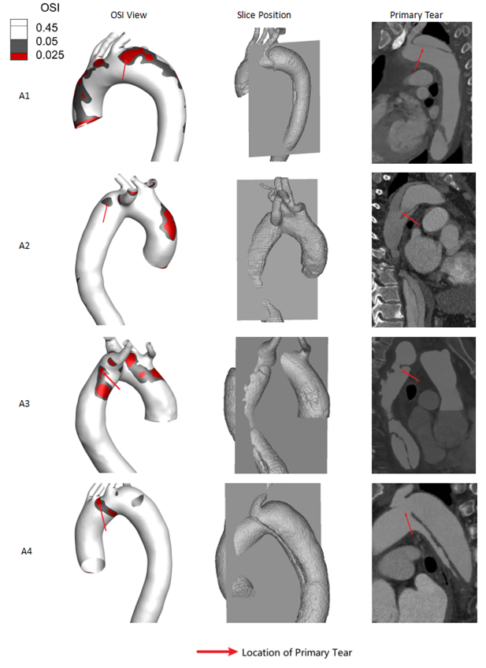SCUPI FREE Program Researcher Publishes Paper in Physics of Fluids
Published on: April 3, 2025 | Views: 564
Recently, Siquan Cheng (Max), a researcher in the Focused Research Extended Experience (FREE) Program at the Sichuan University-Pittsburgh Institute (SCUPI), published a paper as a co-first author in Physics of Fluids, a prestigious SCI journal ranked in the JCR Q1 TOP category.
The SCUPI FREE program is a non-degree research-focused initiative lasting up to two years. It aims to provide participants, who have already obtained a bachelor’s or master’s degree, with specialized research training, professional and career development resources, and opportunities for academic publication.
As one of the first FREE program researchers at SCUPI, also a SCUPI alumnus, Siquan Cheng actively engaged in fundamental research and exploration in fluid mechanics during his graduate studies. Through this process, he developed a solid theoretical foundation and extensive experience in numerical simulation. The FREE program provided him with a focused and efficient research environment, allowing him to deeply participate in various research projects at the SCUPI Biofluid Laboratory and collaborate closely with Dr. Yue Qiu and other team members. Throughout the program, Siquan Cheng gained invaluable research experience by immersing himself in all aspects of scientific research—from literature review, experimental design, and fluid simulations to data analysis, academic writing, and publication.
The FREE program not only provided him with abundant research resources but also created extensive academic exchange opportunities, supporting his comprehensive development in the field of scientific research. Looking ahead, Siquan Cheng will continue to advance research in hemodynamics and its applications in clinical medicine, striving to provide scientific evidence for disease prevention and treatment while contributing to the advancement of personalized medicine.
Article Summary
Aortic dissection (AD) is a physical tear of the aorta where the layers of the aortic wall separate, allowing blood to infiltrate the media layer through a rupture in the intimal lining. This process creates two channels within the aorta: the true lumen (TL) and the false lumen (FL) with potential symptoms such as organ malperfusion. These complications usually result from the damage of endothelial cells, obstruction of mass transport, and adverse arterial remodeling which could be traced back to an abnormal hemodynamic environment caused by the abnormal aortic arch morphology of ARSA . Therefore, there is a potential causation between the ARSA and AD in the hemodynamic field, and so far few studies have been able to identify the underlying connections.
— Excerpt from the article
【Ref: Cheng, S., Qiu, Y., He, D., Wang, L., Weng, C., Yuan, D., & Li, K. (2025). Helical vortex arising from aberrant right subclavian artery induces occurrence of dissection tears. Physics of Fluids, 37(3), 031911. https://doi.org/10.1063/5.0255493】
Background
The abnormal hemodynamic environment induced by the ARSA is closely related to the occurrence of AD. However, no risk assessment method based on hemodynamic and morphological characteristics has been established. This study is part of the hemodynamic research led by Dean Kang Li’s team at SCUPI, in collaboration with Professor Ding Yuan’s team at West China Hospital of Sichuan University. The findings were officially published in Physics of Fluids in March 2025. This research explores the mechanism by which ARSA induces aortic dissection tears using computational fluid dynamics (CFD).
Research Findings
By employing CFD simulations to analyze the hemodynamic characteristics of ARSA patients, the study revealed the presence of persistent helical vortices in the aortic arch and proximal descending aorta. This abnormal flow pattern results in an irregular distribution of wall shear stress and a low oscillatory shear index (OSI < 0.05) in the regions where dissection occurs. Additionally, the presence of ARSA increases the horizontal displacement forces acting on the aortic wall, particularly in the proximal descending aorta. The continuous effect of the characteristic helical blood flow may cause prolonged unidirectional shear stress on the vascular wall, weakening its structural stability and increasing the risk of tearing. These findings suggest a significant association between ARSA and the occurrence of AD.
Research Conclusion
Through CFD simulations, this study provides an in-depth analysis of the hemodynamic characteristics of ARSA patients and reveals the potential impact of abnormal blood flow patterns on the development of aortic dissection. These findings offer new theoretical insights for the early identification of high-risk patients and the optimization of personalized treatment strategies, further advancing research on hemodynamics-based disease prediction and intervention strategies.

Figure 1: Schematic Diagram of CFD Numerical Simulation Boundary Conditions

Figure 2: Streamline Diagrams of Three Model Groups at Four Time Points. At T3, the characteristic helical blood flow is clearly observed in Group A.

Figure 3: Isosurface Images of Helicity in Three Model Groups. Red arrows indicate the locations of characteristic helical flow.

Figure 4: Comparison of Low OSI Regions and Tear Locations
Main Authors

Co-First Author: Siquan Cheng
MSc in Thermal Power and Fluid Mechanics, the University of Manchester, UK;
Research Assistant, Biofluid Laboratory, Sichuan University-Pittsburgh Institute.

Co-First Author: Yue Qiu
Assistant Researcher, West China Hospital of Sichuan University;
Head of Biofluid Laboratory, Sichuan University-Pittsburgh Institute.
Co-Corresponding Author: Chengxin Weng
Doctor of Clinical Medicine, Postdoctoral Fellow;
Vascular Surgeon, West China Hospital of Sichuan University;
General Surgery – Vascular Surgery Ward.
Co-Corresponding Author: Ding Yuan
Doctor of Medicine, Postdoctoral Fellow;
Chief Physician/Associate Professor, Master’s Supervisor, West China Hospital of Sichuan University;
General Surgery – Vascular Surgery Ward.

Co-Corresponding Author: Kang Li
Researcher, Biomedical Big Data Research Institute, West China Hospital of Sichuan University;
Associate Dean for Research, Sichuan University-Pittsburgh Institute;
Adjunct PhD Supervisor at the School of Biomedical Engineering, University of Science and Technology of China Suzhou Institute.
The Biofluid Laboratory of SCUPI:
The laboratory focuses on interdisciplinary fields of medical engineering, including orthopedic biomechanics, hemodynamics, and respiratory dynamics. The lab provides efficient and accurate medical finite element simulation technology for research collaboration with hospitals, universities, and research institutions. By eliminating complex and resource-consuming physical experiments, the lab applies advanced technology to effectively solve critical clinical issues.

